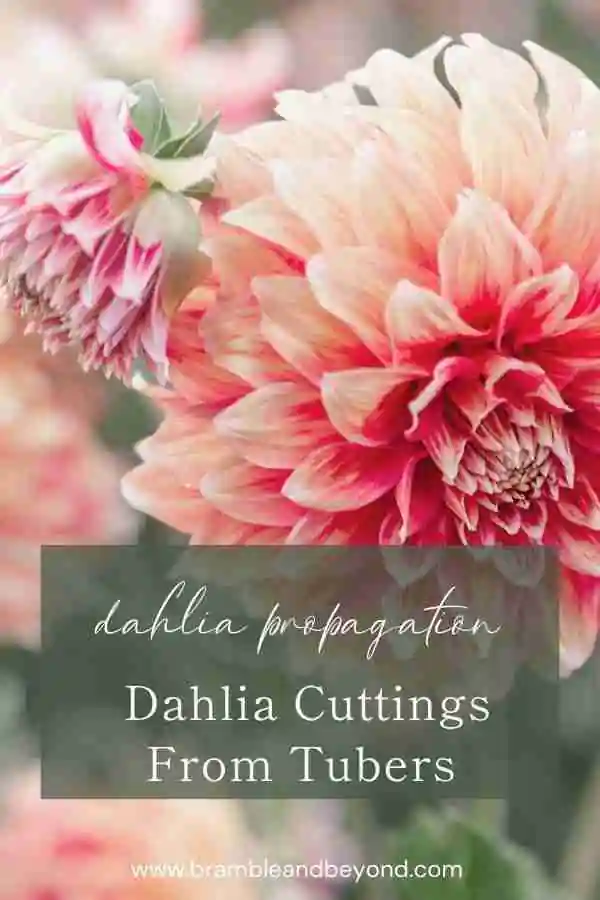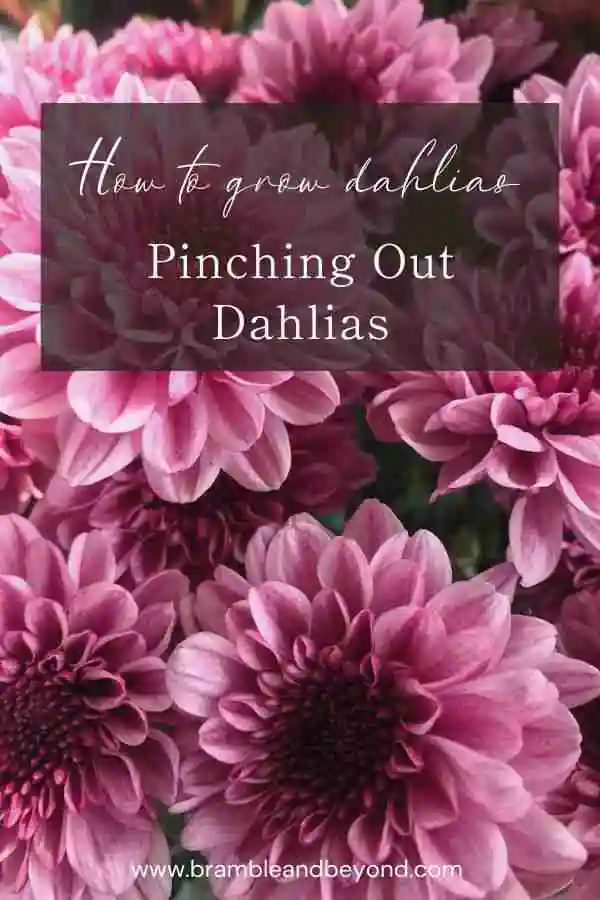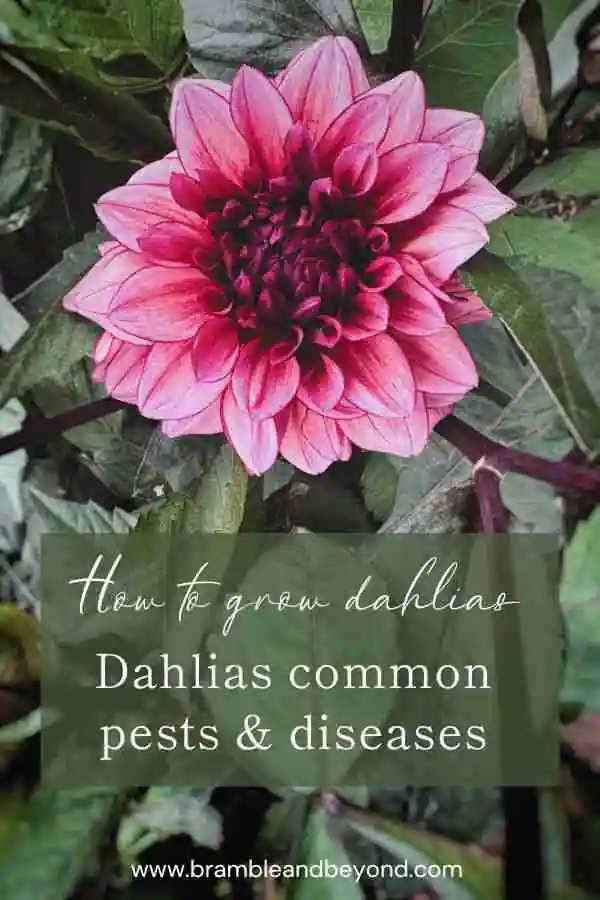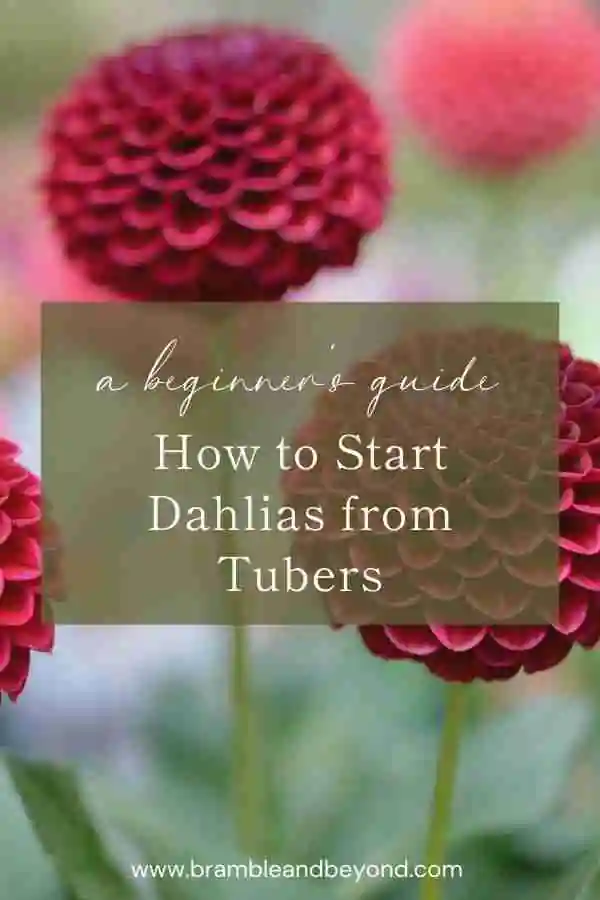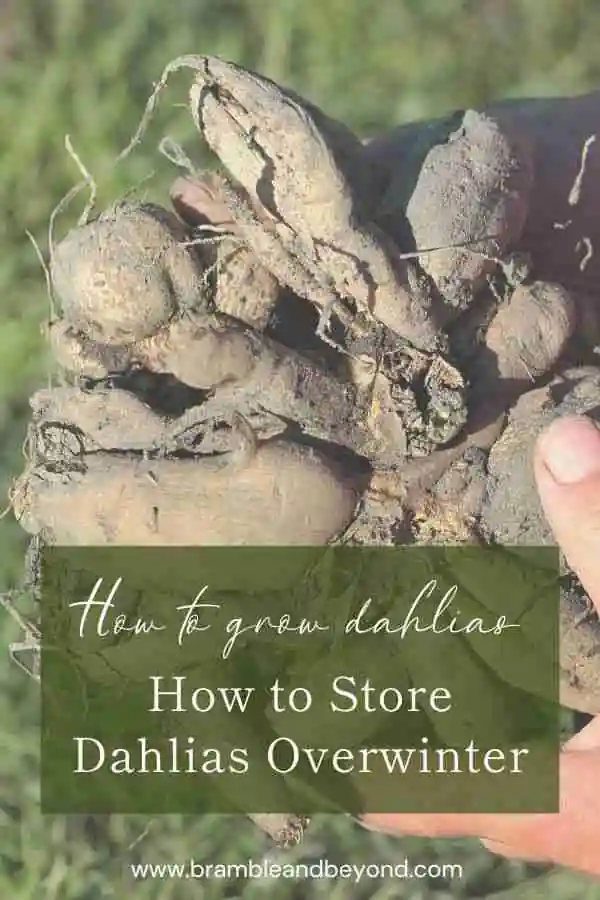Disclosure: This post may contain affiliate links, meaning I get commission if you decide to make a purchase through my links, at no cost to you. Please read my Affiliate Disclosure for more information.
Dahlias, with their bold blooms and vibrant colours, can be the crown jewel of any garden and are essentials to the late summer cut flower garden. But these beauties come with a delicate secret – their hollow and brittle stems. A light breeze can leave them snapped and damaged. But don’t worry, we’ve got your back with an easy solution – homemade dahlia supports!
Homemade dahlia supports are an effective and sustainable way to protect your dahlias from wind damage. There are many different approaches and are easy to make from materials you likely already have on hand.
Let’s dive into the world of dahlias and learn how to give them the support they need to thrive.
The importance of staking dahlias
Dahlias are known for their glorious flowers, some of which can be as large as your head (I’m looking at you, Cafe Au Lait!), and with this comes a problem. No matter how large the flower head, their stems are hollow, which, while helping the plant grow tall and produce beautiful flowers, can also make them vulnerable to wind damage. Stems often have multiple flower heads per stem making the issue even more problematic.
Whilst dahlias are generally quick to recover from a breakage higher up on the plant. They’ve earned their reputation as a ‘cut and come again’ flower for a reason! But, there’s a catch. The danger comes when the plant stem breaks at the base. The chances of recovery for that stem are slim, and sadly, you’ve just lost an entire growing stem from your flowering plant, which can put a dent in your garden’s productivity.
By setting up a sturdy support at the base and extending it to at least a third of the way up your dahlia plants, you can give them the boost they need to grow robust and healthy, free from the fear of snapping. So, let’s help our glorious dahlias stand tall and bloom their hearts out!
Options for staking your dahlias
There are several ways you can stake your dahlias. Here are just a few ideas:
- Staking
- Caging
- Hooping
- Netting
Each method has its own set of benefits and can be chosen based on the size and growth of your dahlias, or maybe more importantly how many plants you need to stake. I’ll cover each in more detail later.
Choosing the right support material
When it comes to choosing a support material for your dahlias, you have a few options – Wood, Metal, Bamboo, and Plastic. All of these can work well, as long the material is sturdy enough to support the weight of the dahlia plant, then they are good to use.
I have used bamboo stakes a lot in previous years as they are cheap to buy. However, you need to be careful with them, as shorter lengths tend not to be very thick and then they are not strong enough to support a large dahlia plant. Try and use canes that are at least 2-3cm thick. Here are some on Amazon.
I dream of having beautiful iron stakes to use in the cutting patch, both for decoration and support, but so far the budget doesn’t allow it. Eventually, I think I am going to try and use these fencing pins from Amazon. I’m hopeful they can double as both support and a label holder.
Whatever staking material you choose, do beware that a straight stick poking out of your flower bed is a bit of a hazard. Make sure you soften the ends to avoid poking yourself in the eye when picking the flowers. Think tennis balls, ping pong balls or small flower pots placed on the tips. These can all be painted to make them look less unsightly.
Homemade dahlia support ideas
While not all of our dahlias need support, those that grow taller than 90 cm will really appreciate a helping hand! And even the shorter ladies, like Snowflake and Urchin, can benefit from a bit of staking – it helps hold their beautiful blooms up high, instead of letting their stems droop towards the ground and get splashed with dirt when it rains.
Supporting individual dahlia plants
If you’ve got a lovely bunch of dahlia plants scattered throughout your garden, then individually staking each plant is your best bet. Having their own stake allows each plant to be tied securely and comfortably.
Be sure to place the stake a little distance from the centre to avoid damaging the precious tubers. The distance will depend on how big your tuber is. You can start tying them in when they’ve reached a height of about 30cm.
As the plant gets taller, gently tie its main stems to the stake. Remember to leave a bit of room for it to sway in the wind. If it’s tied too tight and can’t move when it needs to, this too can cause the stem to snap, and it makes it difficult to grow! You might find it easier to use two stakes per plant, giving it a more flexible structure to grow into.
An alternative to staking is a hazel (or any other flexible wood you have in available to you) cage. As shown in the picture below.

The gaps in the cage should be just big enough to let your lovely plant grow through. This structure gives the plant all the support it needs right at the base, where it counts the most, and saves you the hassle of continuously tying in the plant as it grows. Plus, it gives you the freedom to snip off those beautiful flowers with ease.
A similar idea is detailed here by Zoe Woodward Gardening. Her plants always look spectacular, but I must admit, whilst this technique looks very robust I haven’t found the need to be quite so meticulous.

Supporting multiple dahlia plants
If you are planting your dahlias in rows or in a group, then it is much easier to use some sort of corralling method that allows you to support the plants en-masse rather than individually.
A tried and tested method is using some simple stakes and a ball of garden twine. Just place the stakes about one meter apart along both sides of your lovely dahlia bed. Make sure to push them in until they’re nice and secure!
I know it might be tempting to use fewer stakes and space them further apart, but trust me, over time, the twine tends to sag and doesn’t provide the support your dahlias need. When your plants reach around a 30cm tall, that’s the perfect time to install the first row of twine, about 30-45cm off the ground.
As your plants get taller, just keep encircling them with more twine at 30cm intervals. If you plant your dahlias in the same spot each year, you might even be able to leave the stakes in place from one season to the next.
Alternatively, the twine could be replaced with jute netting available on Amazon, for the plants to grow through. Personally, I don’t like the green plastic netting, I find it difficult to cut flowers through, I’m not sure why.

Expanding on this approach, I prefer to create something I like to call a cat’s cradle. Again, just using stakes and garden twine, you build up a network of criss-crossing twine so that the plants are supported both at the edges of the rows and within the row. If one piece of twine sags or breaks, then the whole structure is not impacted and you can repair it easily.


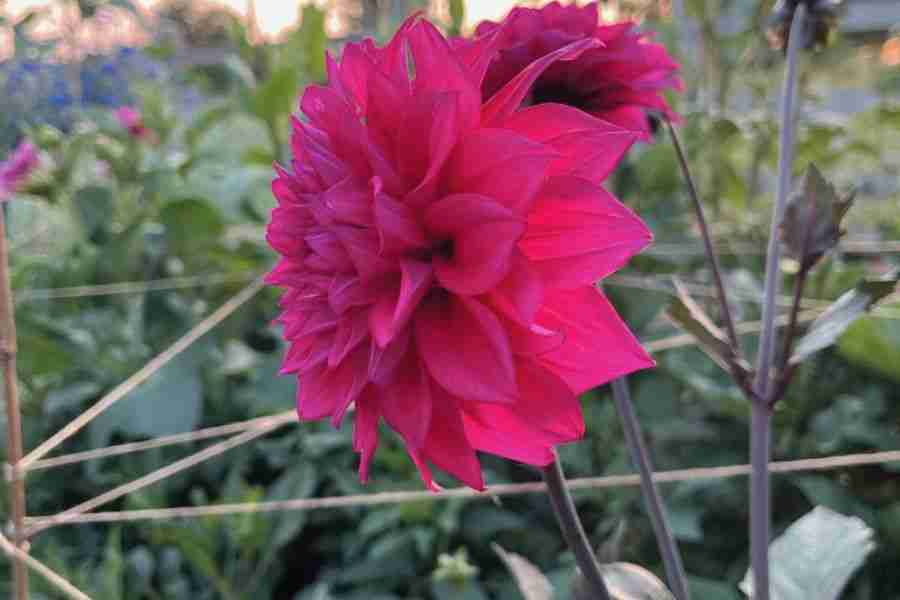
I start with creating the support all around the edges. Then work in a criss-cross fashion between the stakes across the middle of the bed. Here is a video I reocred to show you what I do.
Whatever support structure you choose, once the plants have grown a bit you cannot see the structure, so it doesn’t matter how unsightly it is to begin with.
This is my approach this year.

I have the base structure in place, using bent elder branches which I will eventually add twine when necessary. I have done the same approach on all of the beds, so hopefully I provide support easily before its too late.
UPDATE: I’m hoping the elder doesn’t take root, so far it doesn’t seem to be, but I do have to keep removing leaves that persistently grow from the branches.
When to support your dahlias
If you’re looking to stake individual dahlias, the perfect time is just after planting. This way, you can avoid accidentally damaging the tubers when you put the stakes in. But don’t worry if you forget – it’s never too late to start!
Regularly checking on your dahlias and adjusting their supports is a great habit to get into. It ensures that they’re getting the right amount of support and avoids any harm to the plant.
If you’re planting dahlias in groups, a good rule of thumb is to add support as soon as one of your plants grows beyond 30cm. I find it easiest to set up the support shortly after planting – that way, I’m never caught off guard.
Properly supporting your dahlias not only helps them look their best, but it also maximises their flower production. Plus, well-supported and tidy plants make it much easier to keep up with ongoing maintenance tasks like weeding and harvesting. Also, having your dahlias up off the ground helps to minimise pest and disease problems.
As a fellow gardener and lover of dahlias, I understand the joy these flowers bring and the worries that come with their care. I’ve faced the same challenges and discovered that my homemade dahlia supports are a game-changer. Believe me, the peace of mind knowing your dahlias are safe is priceless. And remember, every garden is unique, so don’t be afraid to experiment and see what works best for you.
Tips for growing your dahlias
- Divide your dahlias: To produce good sized productive dahlia plants, it is a good idea to divide the tuber every few years. If the tuber is too large, then you get increasing amount of foliage and poorer quality blooms.
- Starting your dahlias: From March onwards you can start your dahlias tubers growing in pots in a protected growing space. The space doesn’t need to be heated, but it does need to have light and be protected from frost.
- Propagate your dahlias: Once your potted up dahlias start producing more than 5 new shoots you can take cuttings of any of the extra cuttings, to create new plants that will flower and create a tuber within this growing season.
- Pinch out shoots: Once you have stems that have a few sets of leaves, then pinch out the growing tip. This will encourage the plant to produce more lateral growth and flowering stems.
- Planting: When planting your dahlias, plant out the plants deep enough to cover the tuber. Place the tubers about 15cm (6 inches) deep. Space the tubers/plants about 40cm – 70cm apart. Only plant out once the risk of frost has passed. In the UK this is generally mid May.
- Watering: After planting, water them in well. After the initial watering, I prefer to water all my plants (if I need to water) with a long deep drink, rather than a light consistent watering. I think this encourages the plants to go in search of their own water, making them more drought tolerant.
- Provide support: Dahlias, especially tall varieties, will need staking or other support to prevent them from toppling over under the weight of their blooms. It is best to get this in place before you need it, rather than waiting until it is too late.
- Protect from pests: Avoid chemical pesticides in your dahlia bed. Instead, encourage beneficial insects, try companion planting, use physical barriers, or try homemade, eco-friendly sprays.
- Protect from frost: In the autumn, after the first frost, either cut back your dahlias and mulch heavily to protect the tubers over the winter. Or lift them and store them somewhere cool and dry overwinter.


